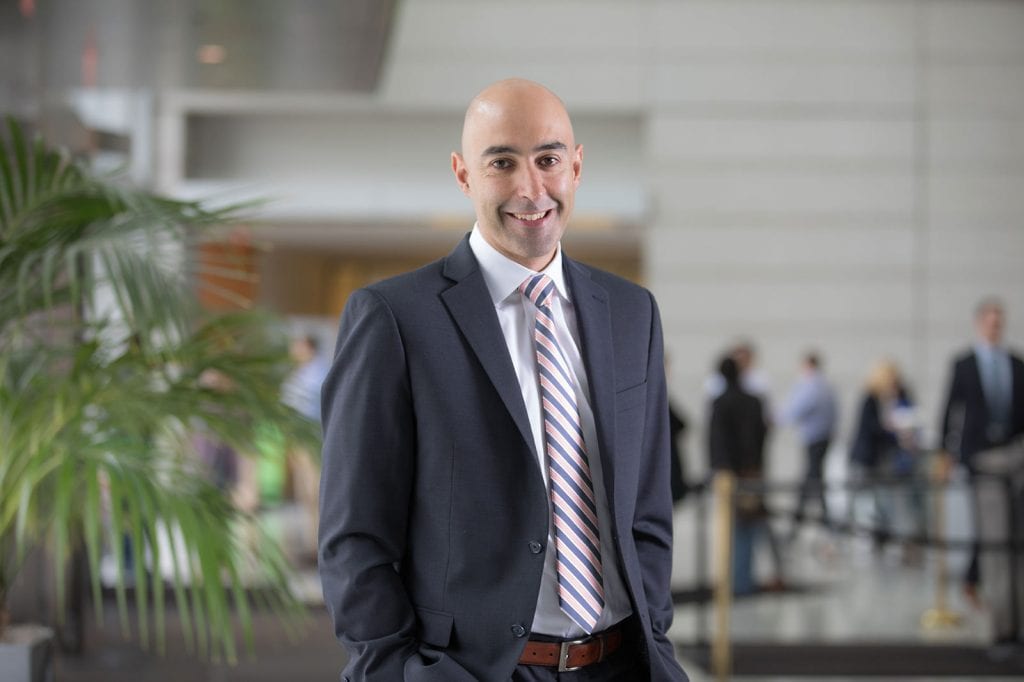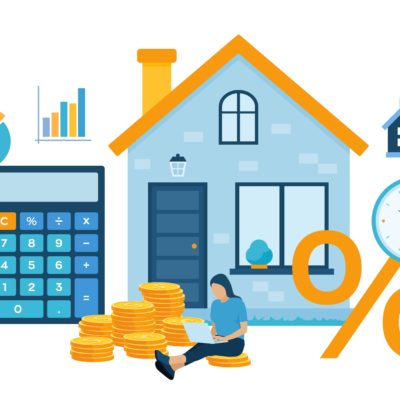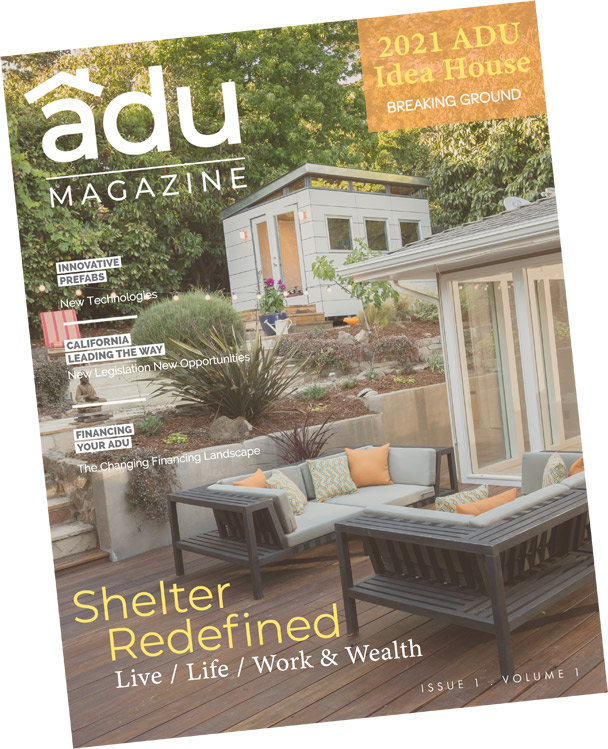
Sam Khater doesn’t make assumptions about accessory dwelling units. He lets the data speak. And data from a research project he recently conducted, as chief economist for Freddie Mac, tells Khater that ADUs are having a moment.
Khater spoke to ADU Magazine about the research and a subsequent article that Freddie Mac published on its findings. Following find selected highlights and excerpts from that Question and Answer session.

…we’ve seen a three to four-fold increase in ADU transactions which, to me in my mind, I think, implies that it’s gotten easier to finance on the ADU side.
– Sam Khater, Chief Economist for Freddie Mac
ADU Magazine: How much of your time is talking about ADUs these days?
Sam Khater: Because of the article, it’s created a flurry of interest. But before doing this article, from a research perspective, virtually none. I’ve been interested in ADUs for awhile. And other flexible forms of housing.
One of the issues that I have with the market today is not only are we under-building — we estimate we’ve under-built by about 2.5 million units or so and it’s getting worse in this crisis — but the few units we are building are all high-end single-family and high-end multi-family. There’s this gaping, missing middle that’s emerged over the past couple decades now.
A lot of the missing middle is just the (heterogeneous)… duplexes, triplexes, manufactured housing, garden apartments, ADUs. It’s in this middle part of the housing segment that serves many different parts of the income distribution that is slowly disappearing before our eyes and it’s one of the reasons that’s causing the housing crunch.
I mean, there’s several reasons (for the housing crunch). Some are demand-side. A lot of those have to do with the stagnation of incomes and the polarization of incomes. But then there’s the supply side, which is making it much worse. Not only are we getting stagnating incomes, but home prices continue to rise… over the past few decades, even with the Great Recession continuing to spiral up and making affordability more of an issue.
Not withstanding, one countervailing factor for all that is we’re at record low rates and that’s helping a lot. But there’s a little bit of a mirage there. That allows folks to be able to afford the mortgage payment, but the downpayment is a huge hurdle. This is the one issue I have with economists who say housing’s so affordable. I’m like, ‘No, it’s not’…
On the construction side, lumber prices are going through the roof. So, if you’re doing any wood-related stuff, that’s gotten a lot more expensive in the past 3-4 months. A lot of it has to do with the pandemic. Lots of people are doing home improvements. My own neighborhood… you can’t even park. You’ve got so many trucks, like home improvement trucks, so there’s been a run on all of the lumber.
So short answer, historically spent very little time here at Freddie, but it’s definitely gotten attention. I can tell you, it’s actually really interesting, that article — and they knew we were working on it — got a lot of attention internally, more than I thought and in terms of trying to do something about it. Because again, it’s a flexible housing for intergenerational housing or to give folks, single-person households, the fastest demographic category out there, a growing category. Other than high-end multi-family on the new construction side, there’s nothing else out there. The affordable stuff, those people are not going to give up those places. They hang onto them as much as they can.
ADU: What was the motivation for the article? What was the genesis of it?
Khater: Overall, and this is more of an internal thing, I’ve always been interested in producing more innovative research, non-standard… We selected ADUs, because I just think it’s an interesting topic. The innovative part of the research is that there’s no standard data on ADUs at all. The census doesn’t even know, they don’t collect data on ADUs.
ADU Magazine: How much of your time is talking about ADUs these days?
Sam Khater: Because of the article, it’s created a flurry of interest. But before doing this article, from a research perspective, virtually none. I’ve been interested in ADUs for awhile. And other flexible forms of housing.
One of the issues that I have with the market today is not only are we under-building — we estimate we’ve under-built by about 2.5 million units or so and it’s getting worse in this crisis — but the few units we are building are all high-end single-family and high-end multi-family. There’s this gaping, missing middle that’s emerged over the past couple decades now.
A lot of the missing middle is just the (heterogeneous)… duplexes, triplexes, manufactured housing, garden apartments, ADUs. It’s in this middle part of the housing segment that serves many different parts of the income distribution that is slowly disappearing before our eyes and it’s one of the reasons that’s causing the housing crunch.
I mean, there’s several reasons (for the housing crunch). Some are demand-side. A lot of those have to do with the stagnation of incomes and the polarization of incomes. But then there’s the supply side, which is making it much worse. Not only are we getting stagnating incomes, but home prices continue to rise… over the past few decades, even with the Great Recession continuing to spiral up and making affordability more of an issue.
Not withstanding, one countervailing factor for all that is we’re at record low rates and that’s helping a lot. But there’s a little bit of a mirage there. That allows folks to be able to afford the mortgage payment, but the downpayment is a huge hurdle. This is the one issue I have with economists who say housing’s so affordable. I’m like, ‘No, it’s not’…
On the construction side, lumber prices are going through the roof. So, if you’re doing any wood-related stuff, that’s gotten a lot more expensive in the past 3-4 months. A lot of it has to do with the pandemic. Lots of people are doing home improvements. My own neighborhood… you can’t even park. You’ve got so many trucks, like home improvement trucks, so there’s been a run on all of the lumber.
So short answer, historically spent very little time here at Freddie, but it’s definitely gotten attention. I can tell you, it’s actually really interesting, that article — and they knew we were working on it — got a lot of attention internally, more than I thought and in terms of trying to do something about it. Because again, it’s a flexible housing for intergenerational housing or to give folks, single-person households, the fastest demographic category out there, a growing category. Other than high-end multi-family on the new construction side, there’s nothing else out there. The affordable stuff, those people are not going to give up those places. They hang onto them as much as they can.
ADU: What was the motivation for the article? What was the genesis of it?
Khater: Overall, and this is more of an internal thing, I’ve always been interested in producing more innovative research, non-standard… We selected ADUs, because I just think it’s an interesting topic. The innovative part of the research is that there’s no standard data on ADUs at all. The census doesn’t even know, they don’t collect data on ADUs.
ADU: Tell me in general, financing an ADU, how easy is it these days? I would assume it’s getting a little easier in recent years.
Khater: Hard to say. Again, there’s just no data on it. That’s one of the things we wanted to do with this was issue a little bit of a soft challenge to the industry to get more data around it. But anecdotally, you hear that it’s in some respects getting easier. I would argue also that in some respects it might be getting harder.
On the easier side, on the secondary market at Freddie, we’ve got this renovation-type product that includes ADUs. Anytime the secondary market… if they can offer financing for something, that makes it much easier for the banks to lend. Because with the secondary market, once the bank issues the loan, they can turn around (back) and sell it to us and then we’ll pay them for that loan. We’ll cycle that money and put it into another loan. And that’s good for the bank. Otherwise then, that loan’s going to stay on their books if they can’t offload it. I think, and this applies to Fannie (Mae) as well, if there’s a secondary outlet, that makes it a lot easier on the banks. So, in that sense, it’s easier.
On the harder side, in the past 10 years, there’s been a decline in smaller-balanced loans, mortgage loans of any type. A lot of that has to do with kind out of the last recession, the Great Recession – the fixed cost of financing just went up. Because mortgage was at the center of the meltdown of the last recession and many regulators wanted to make sure that that doesn’t happen again. And so, the rules of the game got tighter for mortgage and the documentation got tighter. The cost to originate the mortgage went up.
That impacts the smaller balance loans because as a percentage of the UPD, the loan amount, these fixed costs are high. For many banks then it just becomes unprofitable for them to lend, so they don’t do it. That, I think, is a concern. This is sort of an issue that the mortgage industry needs to sort out.
ADU: What sort of effect on financing is the pandemic having? And are loan restrictions getting tighter?
Khater: Underwriting has gotten tighter, as you would expect in the worst recession in the U.S. and it’s not even close. So, underwriting’s gotten tighter in a couple of dimensions: From a debt-to-income (perspective), a little bit tighter; and from a credit score perspective, a little bit tighter.
But it is sometimes hard to tell, are these supply or demand-driven? Is it the lower credit borrowers applying less, which causes the credit scores of origination to go up, but it’s not so much underwriters tightening, it’s more of self-selection? It is hard to tell. My guess is it’s happening both, but my guess is it’s very difficult to disentangle that. I will tell you it’s gotten tighter on the credit score side and it’s gotten tighter on the debt-to-income. The three levers are credit score, DTI’s, and LTD’s. LTD’s haven’t shifted that much.
Rates have dropped quite a bit. They’re at historic lows… From a monthly mortgage perspective, that makes the mortgage payment obviously more attractive. And we’re seeing the impact on demand. Purchase application demand is through the roof. You really don’t see that in the home sales numbers yet, but you will over the next couple of months. You’re going to see a pronounced surge in home sales.
ADU: Why do you think that is?
Khater: There’s a two-month lag between the purchase applications that we’re seeing and the closed home sales. There’s just this surge in home sales and… I think a good chunk of it is because of the record-low rates but then also the pandemic part. People are rearranging their living situations because of the pandemic. Just last night, I found out my wife’s parents want to leave New Mexico and move back to the East Coast because they’re not going to see anybody anytime and my wife’s parents are from outside of very western Philly. They weren’t really planning on leaving.
I think you’re seeing a lot of unplanned movements. We’ve heard lots of noise about inner city dwellers looking to move out. I can tell you in DC, I bike a lot in Washington D.C. and, I was just out there yesterday for two or three hours… it looks like a quarter of the city is just gone… I think some of them are sheltering in place but people are just not there. Every day I’m going out, it doesn’t matter day or night, it almost feels like you’re out on a Sunday morning at 6 o’clock. Nobody’s out there.
I wouldn’t at all be surprised if a bunch of these people packed up and went, especially younger people went home or decided to move out of the city. That’s caused the number of transactions to just shoot through the roof, which is just unexpected. We’re in the worst recession, post-war recession. I expected home sales to collapse and they did for like six weeks, seven weeks. But they’re just absolutely booming.
ADU: In general terms, are ADUs in recent years financing-wise starting to have a moment? Is it starting to be a thing that if you’re a homeowner and you want to do this, it’s getting easier?
Khater: All I can speak to is the data we put out in that article, which is we’ve seen a three to four-fold increase in ADU transactions which, to me in my mind, I think, implies that it’s gotten easier to finance on the ADU side. Then otherwise, there’s no way that these ADUs would’ve gotten financed. I think just like anything else, I think a lot of lenders realize when they see a market that’s expanding that, ‘Hey, this is a business opportunity and we should go after it.’
So, here I’m just making a statement based on the data that I see. In other, when I look at the single-family or detached or attached market, condo or whatever, whenever there’s an increase in sales, usually you see financing behind that. Otherwise, those sales wouldn’t happen.
ADU: Is there anything that we haven’t gotten into or anything that would be good for people to know?
Khater: It might be of interest to your readers… but California, you had several markets that were leading the way in terms of growth… (The Los Angeles market) is the fastest-growing one in California.
*This interview has been edited for length and clarity.
- Graham Womackhttps://adumagazine.com/author/graham-womack/
- Graham Womackhttps://adumagazine.com/author/graham-womack/
- Graham Womackhttps://adumagazine.com/author/graham-womack/
- Graham Womackhttps://adumagazine.com/author/graham-womack/







